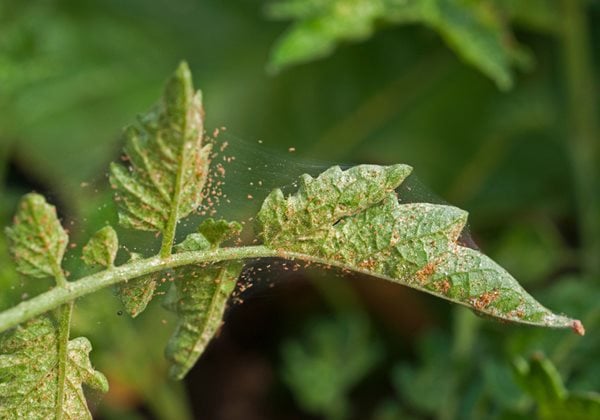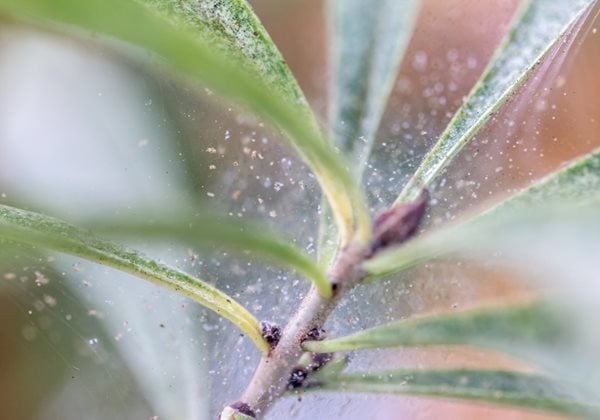HOW TO IDENTIFY AND CONTROL SPIDER MITES ON PLANTS
Keep plants healthy by eradicating these common pests
Red spider mites. Photo by: Catherine Eckert / Shutterstock
Dealing with predatory insects and other pests is one of the least favorite tasks for most gardeners. It’s even more challenging when they are difficult to spot.
WHAT ARE SPIDER MITES?
Spider mites (Tetranychus urticae) are among the most common garden pests and are smaller than the head of a pin, making it hard to identify them. These tick-like bugs are considered arachnids (related to spiders) rather than insects because of their eight legs. There are many different types, occurring in colors of red, green, yellow, or brown, with the most common being the two-spotted spider mite and red spider mite.
When the weather warms in spring, spider mites emerge to feast on plants. This can weaken plants, making them susceptible to disease and other problems. Spider mites reproduce quickly, with each female laying hundreds of eggs. The resulting exponential population growth can cause a serious infestation in a matter of days or weeks.
HOW TO GET RID OF SPIDER MITES
It’s important to identify spider mites on plants early on to avoid an all-out infestation, which is harder to control. Organic methods are safest for people, pets and plants. Take these steps if you think any of your plants are affected. (See below for more on how to identify spider mites and the damage they cause.)
Spray with water:
Use a nozzle attached to a garden hose and create a gentle water spray to dislodge webbing and as many insects as possible. Make sure to get the undersides of the leaves. This also removes dust from the leaves, a favorite hiding spot for mites.
Use insecticidal soap:
Allow plants to dry and apply an organic insecticidal soap. Spray in early morning or evening and avoid using when temperatures exceed 90 degrees F. Reapply every 7-10 days or according to instructions to disrupt the egg hatching cycle.
Homemade remedies:
You can make your own insecticidal soap. Use a mild liquid soap such as Castile or Ivory and mix 1 tablespoon into 1 quart of water. Apply with a spray bottle. Other home remedies include garlic, pepper (capsaicin), peppermint or rosemary.
Neem oil:
A natural extract of the neem tree, neem oil is a general pest repellent that will smother spider mites upon application. This is a longer-lasting solution, and is often used after applying an insecticidal soap. Use as directed and keep away from pets and children. (Read more on how to use neem oil.)
Use other bugs:
Beneficial insects that prey on spider mites offer natural pest control. These include lady bugs, predatory mites, lacewings and spider mite destroyers. These insects are harmless to people, pets and plants. This solution is most effective if you are able to get the good bugs as eggs (adults will generally just fly away).
Extra measures:
If an infestation becomes severe, remove the most affected leaves, place them in a sealed plastic bag and dispose in the garbage. Don’t put them in the compost, as this can spread the problem. In extreme cases, an entire plant may need to be removed.
Avoid chemicals:
Chemical pesticides can upset the ecological balance. This can allow other predatory pests to move in and cause secondary problems.
HOW TO PREVENT SPIDER MITES
Look before you buy:
Inspect indoor and outdoor plants before purchasing to make sure they aren’t infested. (See more on how to choose healthy plants.)
Keep plants healthy:
Make sure plants are well-watered and fertilized. Healthy plants are more able to withstand pests and diseases, while weakened or stressed plants are more susceptible to problems.
Keep the area clean:
Clear weeds and debris out of garden areas where pests can more easily hide.
Bump up moisture levels:
Since spider mites thrive in dry conditions, keep air humidity levels higher around plants.
Use high-quality soil:
Use a high-quality, sterile potting soil to avoid possible soil-borne pests.
HOW TO RECOGNIZE THE PRESENCE OF SPIDER MITES

Photo by: Catherine Eckert / Shutterstock
In cool climates, spider mites overwinter as eggs and hatch in spring; but in warmer climates, they can feed on plants year-round. Emerging larvae become mature adults in just 1-2 weeks, building colonies on the underside of leaves. Several generations occur throughout the growing season, though they can live year-round indoors. Their populations multiply rapidly as the weather warms, becoming most prevalent during summer when conditions are hot and dry.
Inspect plants:
Check plants regularly to identify any pests or diseases, as much as twice a week during drought conditions when spider mites thrive. It’s important to discern whether problems are due to insect damage, disease, nutritional deficiency or cultural practices before determining a course of action.
Know the signs:
Since spider mites are tough to spot with the naked eye, look for telltale signs of their activity. One indication is the presence of fine webbing, particularly on the underside of leaves and at branch intersections.
Take a closer look:
Inspect the underside of affected leaves with a magnifier to see if you can spot them. Hold a piece of white paper underneath the leaves and gently tap the plant to shake bugs loose. Spider mites will be easier to see against the light-colored backdrop.
IDENTIFY SPIDER MITE DAMAGE
Spider mites have piercing-sucking mouthparts that they use to feed on plant sap, extracting fluids from leaf tissues. This results in clusters of tiny white or yellow spots on foliage in a stippled pattern. Leaves can curl and become brown and dull, which is sometimes mistaken as drought stress.
As their numbers grow, spider mite damage becomes more evident. Leaves turn yellow and drop off, while plants become increasingly weakened and unsightly. For shrubs such as azaleas, leaves and flowers can become deformed. In severe cases, complete defoliation can occur, causing the plant to die. For fruit crops, harvests can be greatly diminished.
PLANTS SUSCEPTIBLE TO SPIDER MITES
Spider mites can be found on virtually any type of plant, including trees, shrubs, perennials and annuals. Though any plant can be attacked by spider mites given the right conditions, some are more susceptible than others. These include:
- Cucumbers
- Beans
- Tomatoes
- Blueberries
- Strawberries
Hydroponic setups and houseplants are also vulnerable.
SPIDER MITES ON HOUSEPLANTS

Photo by: Robert Lessmann / Shutterstock.
Quarantine:
Keep new houseplants away from other plants for 30-40 days to prevent possible spread of spider mites.
Keep it humid:
Spider mites thrive in dry conditions. Boost room humidity, particularly in winter when household air is dry. Use a room humidifier or regularly mist plants with a spray bottle. Another alternative is to place plants on trays filled with pebbles and a small amount of water. Don’t allow the bottom of the pot to sit in standing water.
Clean leaves:
Wipe leaves regularly with a damp cloth to remove and deter pests.
Remove pests:
Spray affected plants with insecticidal soap or use a cotton swab dipped in diluted 70% rubbing alcohol to kill visible pests.
Use neem oil cautiously:
If applying neem oil, take care not to get the oil on clothing, furniture or other household items.
RELATED:
How to Get Rid of Aphids Naturally
Getting Rid of Japanese Beetles
How to Get Rid of Grub Worms
How to Get Rid of Whiteflies
Tomato Diseases, Pests & Problems


